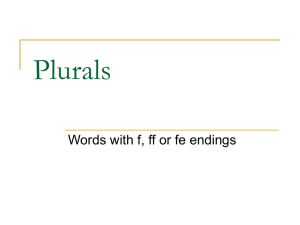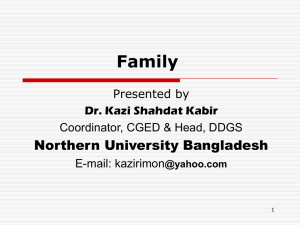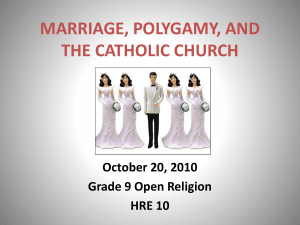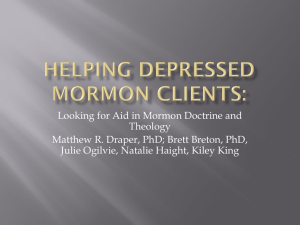File
advertisement
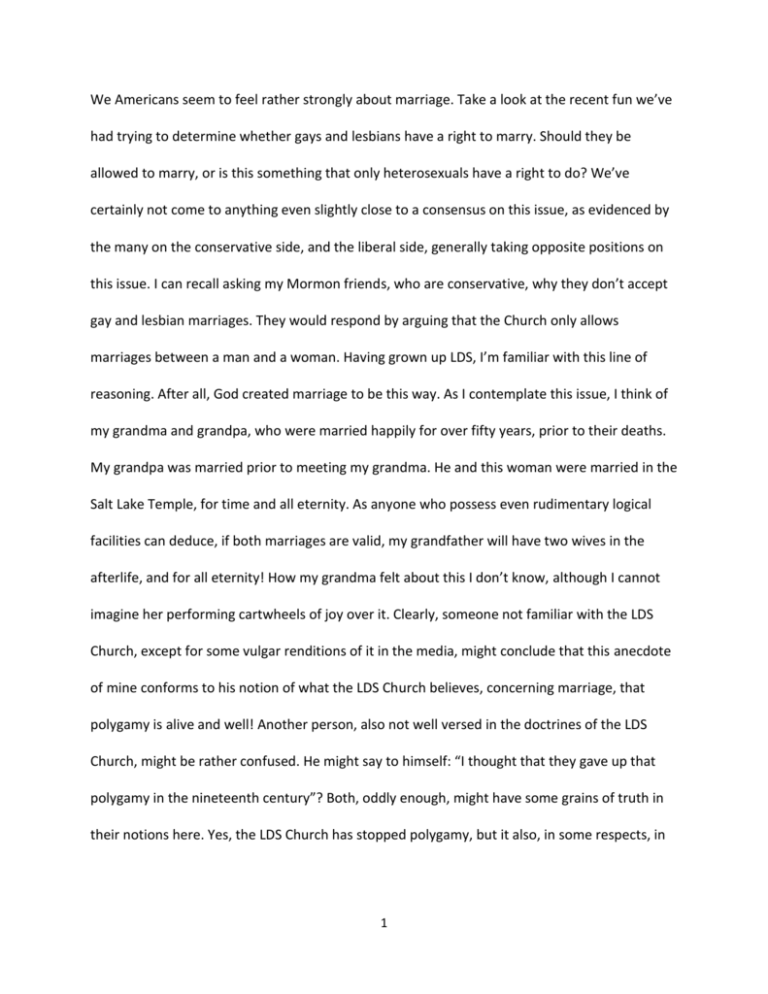
We Americans seem to feel rather strongly about marriage. Take a look at the recent fun we’ve had trying to determine whether gays and lesbians have a right to marry. Should they be allowed to marry, or is this something that only heterosexuals have a right to do? We’ve certainly not come to anything even slightly close to a consensus on this issue, as evidenced by the many on the conservative side, and the liberal side, generally taking opposite positions on this issue. I can recall asking my Mormon friends, who are conservative, why they don’t accept gay and lesbian marriages. They would respond by arguing that the Church only allows marriages between a man and a woman. Having grown up LDS, I’m familiar with this line of reasoning. After all, God created marriage to be this way. As I contemplate this issue, I think of my grandma and grandpa, who were married happily for over fifty years, prior to their deaths. My grandpa was married prior to meeting my grandma. He and this woman were married in the Salt Lake Temple, for time and all eternity. As anyone who possess even rudimentary logical facilities can deduce, if both marriages are valid, my grandfather will have two wives in the afterlife, and for all eternity! How my grandma felt about this I don’t know, although I cannot imagine her performing cartwheels of joy over it. Clearly, someone not familiar with the LDS Church, except for some vulgar renditions of it in the media, might conclude that this anecdote of mine conforms to his notion of what the LDS Church believes, concerning marriage, that polygamy is alive and well! Another person, also not well versed in the doctrines of the LDS Church, might be rather confused. He might say to himself: “I thought that they gave up that polygamy in the nineteenth century”? Both, oddly enough, might have some grains of truth in their notions here. Yes, the LDS Church has stopped polygamy, but it also, in some respects, in 1 the eternal scheme of things, hasn’t! I recall asking other members, after learning of my “two grandmas’’ situation in the next world, whether this applies to Brigham Young. And they told me yes. Brigham Young does keep all his wives for eternity, as does Joseph Smith and every other Church member who became a polygamist prior to the Church officially abandoning the practice of polygamy. And, yes, any man now, who marries another woman in the temple, and she subsequently dies, and he re-marries, in the temple, he will be married to both women for eternity. Theoretically, even if in practice this may be unusual or unlikely, he could marry dozens of women. That is, let’s say he marries a woman in the temple, she dies, he then marries another woman, in the temple, and she dies, and this goes on, say, ten times. Aside from the fact that law enforcement might want to look in to the rather unlucky circumstances of this man, he will be married to them all, for eternity. This seems to imply that the LDS Church has not abandoned polygamy, entirely. There seems to be these vestiges, if you will, of it, in the mainstream LDS Church. To fully understand why, it’s important to look at the history of the nineteenth century LDS Church, vis a vis polygamy, as well as the polygamy practiced by members of the splinter LDS Church, in the twentieth and twenty-first centuries. There are certainly remarkable differences. And, although I have great respect for the LDS Church, I left it many years ago, and I’ve realized how ignorant I am of it, and its doctrines Although I remember vividly the memory of my grandparents, and the Church’s position on remarrying, when the women spouse dies, I realized I know really zero concerning how the nineteenth century mainstream LDS Church polygamy differs from LDS Church splinter groups of the twentieth and twenty-first centuries. And there are remarkable differences! But we must start with the leader of both factions, Joseph Smith, JR. 2 Certainly, when one examines how the beliefs and practices originally emerged in the newly formed LDS Church of the nineteenth century, it’s absolutely necessary to start with the LDS Church’s founding prophet, Joseph Smith JR. He was a remarkable man. And one can accept this, regardless of whether one accepts that he’s a true prophet. He has clearly influenced his religion through space and time. He’s, one could say, the ‘ground zero’’, as it were, of Mormonism, and everything proceeds to branch from there. The historian, Richard Bushman, provides excellent insight into Smith: “Around 1820, when he was fourteen, Smith began to receive the revelations that started him on his course as a prophet. Ten years later, on April 6, 1830, he organized the church first known as the Church of Christ.’’1 Hence, we have the beginnings of Mormonism. When does polygamy fit into this picture? Smith established it on the basis of a revelation he had. Bushman points out: “Joseph Smith instituted plural marriage secretly in Nauvoo in the 1840’s, but by the time the Saints had established their beachhead in Utah, its existence was common knowledge. The practice was publicly announced at a church conference in 1852. Smith had married his first plural wife in the early 1830’s in response to a revelation he apparently received in 1831 but said nothing about it for a decade. In 1841, he began to marry additional women until the number grew to more than thirty. (Incomplete records make it impossible to determine the exact number.) Smith probably understood the explosive nature of this new revelation and seems to have resisted complying himself. In 1843, in an effort to 11 MORMONISM: A Very Short Introduction, By Richard Bushman, Pages 9, 10. OXFORD UNIVERSITY PRESS, 2008. 3 persuade his resistant first wife, Emma, he dictated a transcription of the words he claims to have received.’’2 Certainly the early United States was not exactly conducive to the idea of polygamy being a legitimate option, even though the Christian Bible was near the bedside of perhaps most early Americans; they were likely to be a little rusty about the polygamy in the Old Testament. Joseph Smith certainly believed that his modern incarnation of polygamy had its ration basis in the Old Testament. As Bushman notes: “The revelation offered no rationale for plural marriage satisfactory to modern understanding. The chief justification was that Abraham and the ancient patriarchs had several wives, and Joseph and the church were to follow their lead as part of the restoration of all things. Smith had turned to the Hebrew Bible for the temple and priesthood; now that same search yielded plural marriage.’’3 One might be forgiven for assuming that, subsequent to Smith’s death in 1844, polygamy would have gone to the casket with him. But, under Brigham Young, it continued, and flourished. As Bushman notes: “Plural marriage reached its peak in the decade after its announcement in 1852. In the decennial federal censuses, the highest percentage of the population in polygamous families was in 1860: 43.6 percent. After that the number of plural marriages declined until only 25 percent of the population was in polygamous families in 1880 and 7.1 percent in 1900. The main reason for marrying plurally was religious. The plural marriage rate shot up when church leaders emphasized the principle and declined as the preaching relaxed. The 1850’s, a period of religious reformation in Utah, produced many plural marriages. If asked 2 3 MORMONISM: A Very Short Introduction, Pages 86, 87. MORMONISM: A Very Short Introduction, Page 87. 4 why they entered these relationships, both plural wives and husbands emphasized the spiritual blessings of being sealed eternally and of submitting to God’s will.’’ 4 As the above statistics indicate, Mormonism was in no way completely flooded with plural marriages, even at a time when this practice reached its peak. It reflects that the view, common in the non-Mormon imagination, that more or less every Mormon was involved in a plural marriage, belongs, wel, in the imagination. Although it’s certainly true that the Mormon church taught and practiced polygamy because it was believed that God commanded it, one wonders if there might be non religious reasons for them to practice it? It turns out that the answer is yes. As Bushman explains it: ‘’Besides the doctrinal reasons, the practice made some economic sense. The close study of the marriages in one nineteenth century Utah community revealed that a disproportionate number of plural wives were women who arrived in Utah without fathers or brothers to care for them. As immigration surged, so did plural marriages, integrating single women without support into the society. Since better-off men more frequently married plurally, the practice distributed wealth to the poor and disconnected.’’5 So, we can see that there were some advantages. But, clearly, there existed disadvantages. For example, legally, we see a plethora of bans crafted by the US Congress, in order to eradicate polygamy. Finally, the LDS Church decided to officially abandon the practice of polygamy. This occurred in 1890, by LDS Church President Wilfred Woodruff. 4 5 MORMONISM: A Very Short Introduction, Page 88. MORMONISM:A Very Short Introduction 5 This decision on the part of the LDS Church Prophet was certainly not embraced entirely by all members. And to what extent it was a decision forced by pragmatism, as opposed to purely being the product of divine revelation, we may be required to remain agnostic. But the abandonment of polygamy appears to have been necessary for the Utah territory to become a state. Bushman explains this well: “The Church renounced plural marriage in 1890 as a necessary condition for Utah to achieve statehood. It had been long denied-when the state was otherwise qualified-because of objections to the practice. The Manifesto, as the announcement by church president Wilfred Woodruff was called, did not repudiate polygamy as a principle but declared only that no more plural marriages were being performed. The original plural marriage revelation is still included in the canon of Latter-day Saint scripture. The reason is that the revelation also contains the doctrine of eternal marriage, one of the preeminent tenets of contemporary Mormonism.’’6 Understandably, not everyone found this decision on the part of President Woodruff to be acceptable. It naturally produced uncomfortable questions. Why would God command Mormons to abandon such a seemingly essential doctrine? What was the basis for God “changing his mind’’, if that’s the right way to put it? There seems to be only one discernible reason for Woodruff to declare this Manifesto, and that is to placate the secular officials who had the power to give statehood to the Utah territory. But surely God, being all powerful, would find another way to get statehood, without having to sacrifice his essential doctrine of polygamy? I’m not taking up for the fundamentalists, but I can certainly see why they were a bit troubled. Whether any thought in precisely the terms I mentioned, I don’t know, but I can 6 MORMONISM: A Very Short Introduction, page 89. 6 imagine that they would have comparable questions; anyone would, as a thinking human being. The fundamentalists were clearly troubled by Woodruff’s decision, enough to declare him a “false prophet’’. As Bushman explains the situation: “in the early twentieth century, another split took place following the abandonment of plural marriage in 1890. So-called fundamentalist groups held on to polygamy and claimed to continue authentic Mormonism. They believed that the main body of the church had strayed. The fundamentalists are the groups now notorious in the press for their practice of plural marriage in opposition to anti-bigamy laws.’’7 (Bushman’s statement about “another split’’, refers to the fact that there were two splits. One, after Smith’s death, which produced the RLDS Church, and the fundamentalist one). Did Woodruff simply lack the courage to continue the fight for polygamy? Or did his decision represent a courageous one on its own terms, in that it required the Church to deviate from a divine doctrine, for the sake of survival in this earthly realm? Or, is “courage’’ the wrong word for it. What happened, perhaps, was God let Woodruff know that polygamy had served its purpose, and no longer needed to be explicitly practiced here on earth? Whatever the case may be here, clearly those who believed that the practice of polygamy was essential to being a faithful Mormon rejected the Manifesto. Hence, Mormon fundamentalism was born. Bushman explains some aspects of the fundamentalists: “ They did not give up plural marriage at the end of the nineteenth century, and some still follow the communal economic practices in the manner of the early Mormons. Some of the groups are run by powerful, unchecked male prophets They seem to live up to the fanatic, anti-modern image of isolated Mormonism.’’8 7 8 MORMONISM: A Very Short Introduction, Page 14. MORMONISM: A Very Short Introduction, Page 14. 7 It’s certainly easy, when one considers the plethora of news stories about fundamentalists allowing underage girls to marry much older men, and of child and sexual abuse, (Warren Jeffs being a particularly prominent example), to have no sympathy for them, and consider them in a principally pejorative way. And while it’s certainly justified to view those who engage in the above mentioned crimes as being completely morally reprehensible, it’s important to understand the conundrum, from a belief standpoint, the fundamentalists are in. They believe that the principle of polygamy is God given. And if they abandon it, they’re abandoning an essential doctrine necessary for their salvation. Certainly they don’t wish to be denied salvation for themselves or their families. Hence it becomes possible to empathize and sympathize with them, if not agree with them. As mentioned, fundamentalists deny that Woodruff is a true prophet. J. Max Anderson explains further their views: “Fundamentalists claim to believe in the four LDS Standard Works, the early history of the Church, and the prophets of the restoration up to, and including, John Taylor.’’9 Certainly this indicates some common ground between mainstream Mormons and fundamentalist Mormons, since they all believe in the passage noted above. Hopefully, both groups can work together, for the good of each. One wonders what the relations between these two groups will look like one hundred or so years from now. Hopefully the relations will be good. Both will need to see the common ground that they share, and use that as a basis for better relations. 9 ENCYCLOPEDIA OF MORMONISM: The History, Scripture, Doctrine, and Procedure of The Church of Jesus Christ of Latter Day Saints. Edited By Daniel H. Ludlow. Volume 2. “FUNDAMENTALISM’’ entry by J. Max Anderson, Page 531. 8
